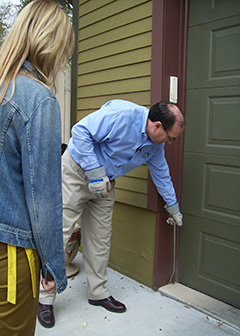Summary
Please enable javascript to play this video.
| Quick Facts: Pest Control Workers | |
|---|---|
|
$44,730 per year
$21.51 per hour |
|
| High school diploma or equivalent | |
| None | |
| Moderate-term on-the-job training | |
| 102,400 | |
| 5% (Faster than average) | |
| 5,100 | |
What Pest Control Workers Do
Pest control workers remove insects, rodents, and other pests that infest buildings and surrounding areas.
Work Environment
Pest control workers often kneel, bend, and crawl in tight spaces to inspect sites. Because there are health risks associated with pesticide use, workers are trained in pesticide safety and typically wear protective gear, which may include gloves, goggles, and respirators. Most pest control workers are employed full time. Working evenings and weekends is common.
How to Become a Pest Control Worker
Pest control workers typically need a high school diploma and receive on-the-job training. State laws require pest control workers to be licensed.
Pay
The median annual wage for pest control workers was $44,730 in May 2024.
Job Outlook
Employment of pest control workers is projected to grow 5 percent from 2024 to 2034, faster than the average for all occupations.
About 13,400 openings for pest control workers are projected each year, on average, over the decade. Many of those openings are expected to result from the need to replace workers who transfer to different occupations or exit the labor force, such as to retire.
State & Area Data
Explore resources for employment and wages by state and area for pest control workers.
Similar Occupations
Compare the job duties, education, job growth, and pay of pest control workers with similar occupations.
More Information, Including Links to O*NET
Learn more about pest control workers by visiting additional resources, including O*NET, a source on key characteristics of workers and occupations.
 United States Department of Labor
United States Department of Labor





